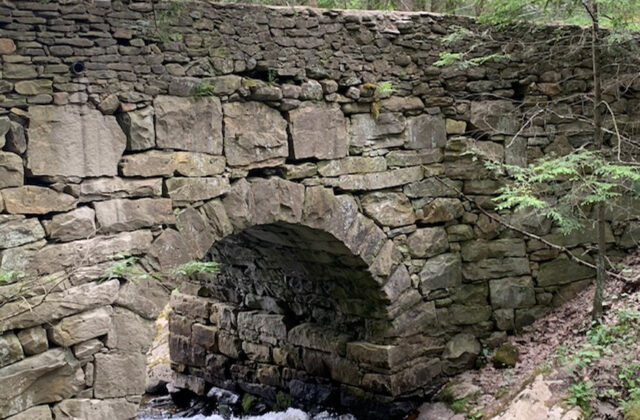A Beautiful Piece of Norfolk History in the Woods
The bridge at Campbell Falls
By Andra Moss
During pre-Revolutionary War days, an early Connecticut entrepreneur, John Campbell, operated a grist-mill alongside a powerful cascade that he may never have imagined would still bear his name three centuries later: Campbell Falls. Today, those falls are part of the Campbell Falls State Park, although some might suppose that they could just as easily have been named “White Falls” in honor of Alain White, the benefactor who donated the first two acres of land containing the falls and a rustic stone bridge to the states of Connecticut and Massachusetts in 1923.
Around the turn of that century, the idea of conservation was new, but several far-thinking individuals and communities realized that lands that locals had always considered open or at least “no one will mind” accessible, were suddenly being swallowed up in large swaths by new industry. Alain White was one such conservationist. He loved the northwestern Conn. countryside where he and his sister, May, had grown up. Their father, John Jay White, was a New York real estate tycoon who relocated his family to Litchfield following the New York City Draft Riots in 1865.
Soon a man of substantial means thanks to his family inheritance, Alain’s stated desire was a simple one: “Wouldn’t it be wonderful to preserve this river, lake and countryside as we see it now?” With May, he eventually preserved nearly 9,000 acres of Conn. land. But for visitors to Norfolk, one particularly special gift was the one made in 1923 of those two initial acres that preserved Campbell Falls.
In reality, the gift was made to both the State of Connecticut and the Commonwealth of Massachusetts in 1923; the states have jointly cared for it ever since. According to the Report of the State Park and Forest Commission to the Governor, 1926/1928, the State of Conn. purchased an additional 100 acres for the park in 1926 for $4,500. (Interestingly, expenses for maintaining the park were a mere $137.57 in 1929/30, perhaps offset by the White Memorial Foundation, which appears in the “Gifts Account” that year with a balance of $10,196.90).
As early as 1928, a Hartford Car Club enthusiast was pointing drivers towards the Falls: “Just to prove that an ‘East Sider’ is not altogether partial, here are a few trips in other directions from Hartford which are the favorites of another of the club members. Go to Norfolk, take the road which joins the road to Caanan, bearing to the right most of the way, and a few miles beyond Norfolk on the border line of Conn and Mass. you will come to Campbell Falls. Here are wonderful falls with massive rock structure for seats and tables.”
It is there, at the top of the falls, where the Whiting River feeds the falls’ mighty plunge, that one finds a beautiful arched stone bridge.
It appears likely that the bridge pre-dated Alain White’s acquisition of that land. A report by the Civilian Conservation Corps surmises, “The large stone-arch bridge which carries the town road over the Whiting River at the falls was reportedly built in 1876 to provide access to a sawmill located above the falls.”
Most signs point toward this being a 19th-century masonry (stone and brick) arch, built by some long-ago local mason (hired by John Campbell?) possessed of engineering and construction skills which have practically disappeared today.
While the falls are, indeed splendid, do not overlook this gloriously humble piece of history and craftsmanship. Says landscape architect (and poetic soul) Stefan Yarabek of the Hudson River Valley, “The Campbell Falls bridge is a classic example of a rusticated stone bridge that was popular from as early as 1860. The style’s popularity rose particularly in the 1890’s as Americans travelled to marvel at Central Park’s wonders– particularly the park’s co-designer Calvert Vaux’s bridges, which danced with the land. True to Vaux’s principles, the (Campbell Falls) bridge is constructed of local stone so that it can blend harmoniously with the land. Built of 200 million year old basalt, the bridge walls are a battened ashlar mix of rectangular and square stones chinked (fitted) with smaller stones for stability. A noteworthy and critically important stabilizing feature of the arch is the sculpted key stones, angular rectangles that support each other by fitting snugly together. The low cheek (side) walls serve to minimally contain the passerby while allowing the visitors to soar across the babbling brook.
The Campbell Falls Bridge is a treat that is a unique portal between the past, present and future.
Come sit a spell and be.”
Photo, top, of the Campbell Falls bridge by Andra Moss.

